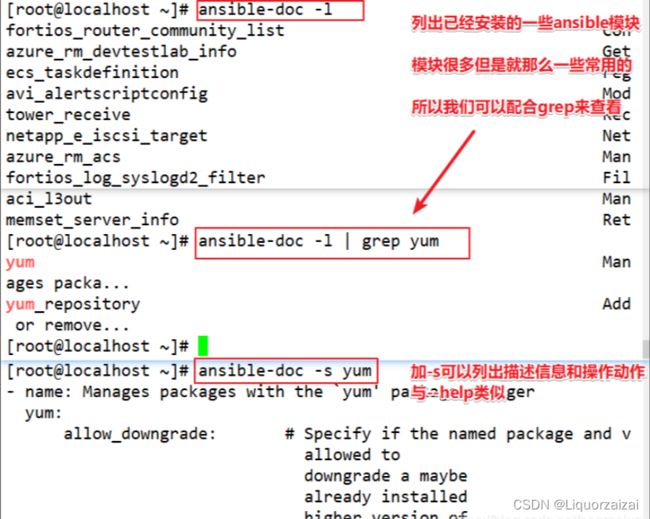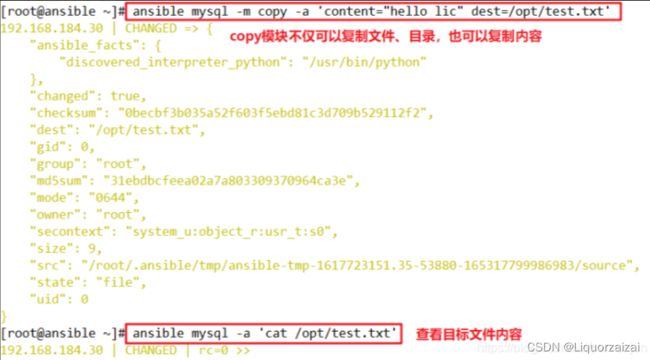Ansible自动化运维之常用模块介绍及部署
目录
一、Ansible的概述1.Ansible简介
2.Ansible具有如下特点
二、ansible环境的安装部署
1.环境准备
2.安装ansible
(1)管理端安装epel扩展源并安装ansible
(2)树型查询工具
(3)配置主机清单
(4)配置密钥对验证
三、Ansible命令行模块
1.Ansible-doc命令 ——默认模块 - 执行命令
2.ansible 常用模块
(1)command模块
(2)cron模块
(3)user模块(用户管理)
(4)group模块 (用户(组)模块)
(5)copy模块 ( 复制模块)
(6)file模块 (指定文件属性)
(7)ping模块(测试连通状态)
(8)service模块(管理服务状态)
(9).shell 模块 (免交互)
(10).yum模块 (安装/卸载软件包)
(11).script 模块 (执行脚本)
(12).setup 模块 -(收集信息)
一、Ansible的概述
1.Ansible简介
Ansible是一个基于Python开发的配置管理和应用部署工具,现在也在自动化管理领域大放异彩。它融合了众多老牌运维工具的优点,Pubbet和Saltstack能实现的功能,Ansible基本上都可以实现。
Ansible能批量配置、部署、管理上千台主机。比如以前需要切换到每个主机上执行的一或多个操作,使用Ansible只需在固定的一台Ansible控制节点上去完成所有主机的操作。
Ansible是基于模块工作的,它只是提供了一种运行框架,它本身没有完成任务的能力,真正执行操作的是Ansible的模块, 比如copy模块用于拷贝文件到远程主机上,service模块用于管理服务的启动、停止、重启等。
Ansible其中一个比较鲜明的特性是Agentless,即无Agent的存在,它就像普通命令一样,并非C/S软件,也只需在某个作为控制节点的主机上安装一次Ansible即可,通常它基于ssh连接来控制远程主机,远程主机上不需要安装Ansible或其它额外的服务。
使用者在使用时,在服务器终端输入命令或者playbooks,会通过预定好的规则将playbook拆解为play,再组织成ansible可以识别的任务,调用模块和插件,根据主机清单通过SSH将临时文件发给远程的客户端执行并返回结果,执行结束后自动删除
Ansible的另一个比较鲜明的特性是它的绝大多数模块都具备幂等性(idempotence)。所谓幂等性,指的是多次操作或多次执行对系统资源的影响是一致的。比如执行 systemctl stop xxx 命令来停止服务,当发现要停止的目标服务已经处于停止状态, 它什么也不会做,所以多次停止的结果仍然是停止,不会改变结果,它是幂等的,而 systemctl restart xxx 是非幂等的。
Ansible的很多模块在执行时都会先判断目标节点是否要执行任务,所以,可以放心大胆地让Ansible去执行任务,重复执行某个任务绝大多数时候不会产生任何副作用。
2.Ansible具有如下特点
①部署简单,只需在主控端部署Ansible环境,被控端无需做任何操作
②默认使用SSH协议设备进行管理;
③主从集中化管理
④配置简单、功能强大、扩张性强:
⑤支持API及自定义模块,可以通过Pyhton轻松扩展
⑥通过playbooks 来定制强大的配置、状态管理
⑦对云计算平台、大数据都有很好的支持
二、ansible环境的安装部署
1.环境准备
管理端: 192.168.40.60 ansible
被管理端: 192.168.40.50
被管理端: 192.168.40.40
2.安装ansible
(1)管理端安装epel扩展源并安装ansible
yum install -y epel-release //先安装 epel 源
yum install -y ansible
 (2)树型查询工具
(2)树型查询工具
yum -y install tree
tree /etc/ansible
//ansible 目录结构
/etc/ansible/
ansible.cfg #ansible的配置文件,一般无需修改
hosts #ansible的主机清单,用于存储需要管理的远程主机的相关信息
roles/ #公共角色目录
(3)配置主机清单
cd /etc/ansible
vim hosts
[webservers] #配置组名
192.168.40.50 #组里包含的被管理的主机IP地址或主机名(主机名需要先修改/etc/hosts文件)
[dbservers]
192.168.40.40
 (4)配置密钥对验证
(4)配置密钥对验证
ssh-keygen -t rsa #一路回车,使用免密登录
sshpass -p '123456' ssh-copy-id [email protected]
sshpass -p '123456' ssh-copy-id [email protected]
或者
ssh-copy-id [email protected]
ssh-copy-id [email protected]
三、Ansible命令行模块
1.Ansible-doc命令 ——默认模块 - 执行命令
适合使用简单的命令,无法支持"<",">","|",";","&"等符号
ansible-doc命令常用于获取模块信息及其使用帮助
//列出所有已安装的模块;注:按q退出
ansible-doc -l
//-s列出yum模块描述信息和操作动作
ansible-doc -s yum
 2.ansible 常用模块
2.ansible 常用模块
命令格式: ansible [主机] [-m 模块] [-a args]
参数
(1)command模块
//指定ip执行date
ansible 192.168.40.60 -m command -a 'date'
//指定分类执行date
ansible webserver -m command -a 'date'
ansible mysql -m command -a 'date'
//所有hosts主机执行date
ansible all -m command -a 'date'//如果不加-m模块,则默认运行command模块
ansible all -a 'ls /'
(2)cron模块
该模块适用于管理cron计划任务的,其使用的语法跟我们的crontab文件中的语法一致
查看cron模块信息
ansible-doc -s cron
#查看cron模块信息
ansible-doc -s cron#webserver:分类 -m指定模块 -a输出模块内的指令 分钟:每分钟,工作:输出hello,工作名称:test
ansible webserver -m cron -a 'minute="*/1" job="/usr/bin/echo hello" name="test"'#查看计划性任务命令
ansible webserver -a 'crontab -l'#移除计划性任务
ansible webserver -m cron -a 'name="test" state=absent'
(3)user模块(用户管理)
模块主要是用来管理用户账号
user模块是请求的是useradd,userdel,usermod三个指令
查看user模块信息
ansible -a user
//创建用户test01
ansible mysql -m user -a 'name="test01"'
//查看创建的用户信息
ansible mysql -a 'tail /etc/passwd'
//删除用户test01
ansible mysql -m user -a 'name="test01" state=absent'
(4)group模块 (用户(组)模块)
该模块主要用于添加或删除组。
group模块请求的是groupadd,groupdel,groupmod三个指令。
查看group模块信息
ansible-doc -s group
ansible mysql -m user -a 'name="test01"'
//创建组
ansible mysql -m group -a 'name=mysql gid=300 system=yes'
//查看组信息
ansible mysql -a 'tail /etc/group'
//使用user模块向组里添加成员
ansible mysql -m user -a 'name=test01 uid=306 system=yes group=mysql'ansible mysql -a 'id test01'
(5)copy模块 ( 复制模块)
对文件进行有效的复制
ansible-doc -s copy
ansible mysql -m copy -a 'src=/etc/fstab dest=/opt/fstab.back'
ansible mysql -a 'ls /opt'
ansible mysql -a 'cat /opt/fstab.back'ansible mysql -m copy -a 'content="hello lic" dest=/opt/test.txt'
ansible mysql -a 'cat /opt/test.txt'
 (6)file模块 (指定文件属性)
(6)file模块 (指定文件属性)
ansible-doc -s file
ansible mysql -m user -a 'name=mysql system=yes'
ansible mysql -m file -a 'owner=mysql group=mysql mode=600 path=/opt/test.txt'
ansible mysql -a 'ls -l /opt/test.txt'#创建
#ansible mysql -m file -a 'path=/opt/abc.txt state=touch'ansible mysql -m file -a 'src=/opt/test.txt path=/opt/test.txt.link state=link'
ansible mysql -a 'ls -l /opt'#移除文件/opt/test.txt
ansible mysql -m file -a 'path=/opt/test.txt state=absent'
(7)ping模块(测试连通状态)
ansible all -m ping
(8)service模块(管理服务状态)
service:用于管理服务运行状态
ansible-doc -s service
[root@localhost ~]# ansible webservers -m service -a 'name=httpd enabled=true state=started'
##启动httpd服务,前提是将httpd服务安装好
192.168.182.22 | CHANGED => {
"ansible_facts": {
"discovered_interpreter_python": "/usr/bin/python"
},
"changed": true,
"enabled": true,
"name": "httpd",
"state": "started",
......
[root@localhost ~]# ansible webservers -m service -a 'name=httpd enabled=true state=stopped' #关闭服务
(9).shell 模块 (免交互)
shell 模块可以使用"<",">","|",";","&"等符号特殊符号,使用方法与 command 模块一致。
ansible-doc -s shell
ansible mysql -m user -a 'name=zhangsan'
ansible mysql -m shell -a 'echo 123123 | passwd --stdin zhangsan'
(10).模块 (安装/卸载软件包)
yum:使用yum软件包管理器安装,升级,降级,删除和列出软件包和组
[root@localhost ~]# ansible webservers -m yum -a 'name=httpd'
##安装httpd服务
[root@localhost ~]# ansible webservers -m yum -a 'name=httpd'
192.168.40.60 | CHANGED => {
"ansible_facts": {
"discovered_interpreter_python": "/usr/bin/python"
},
"changed": true,
"changes": {
"installed": [
"httpd"
]
},
......
[root@localhost ~]# ansible mysql -m yum -a 'name=httpd state=absent'
##移除httpd服务
(11).script 模块 (执行脚本)
[root@localhost ~]# cd /opt/
[root@localhost opt]# vim test.sh
#!/bin/bash
echo "this is test script" > /opt/script.txt
chmod 666 /opt/script.txt
[root@localhost opt]# chmod +x test.sh[root@localhost opt]# ansible all -m script -a 'test.sh' #使用script模块执行创建的脚本
192.168.200.30 | CHANGED => {
"changed": true,
"rc": 0,
"stderr": "Shared connection to 192.168.200.30 closed.\r\n",
"stderr_lines": [
"Shared connection to 192.168.200.30 closed."
],
"stdout": "",
"stdout_lines": []
}
192.168.200.40 | CHANGED => {
"changed": true,
"rc": 0,
"stderr": "Shared connection to 192.168.200.40 closed.\r\n",
"stderr_lines": [
"Shared connection to 192.168.200.40 closed."
],
"stdout": "",
"stdout_lines": []
}
(12).setup 模块 -(收集信息)
ansible-doc -s setup
#获取MySQL组主机的facts信息
ansible mysql -m setup
Ansible facts 是远程系统的信息,主要包含IP地址,操作系统,以太网设备,mac 地址,时间/日期相关数据,硬件信息等信息。














